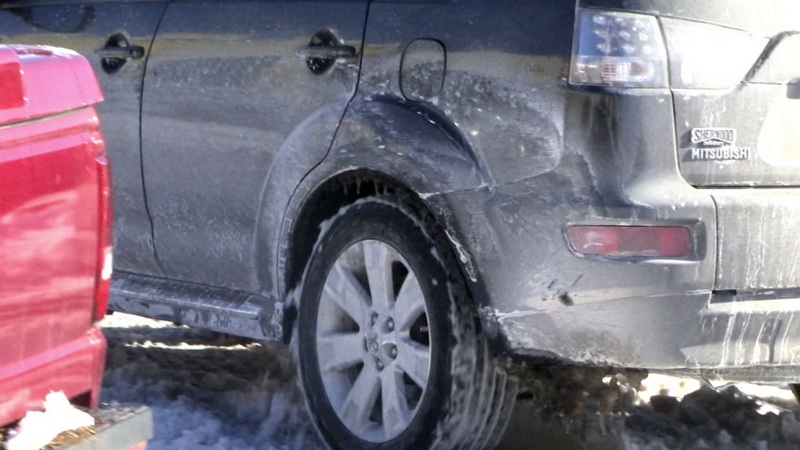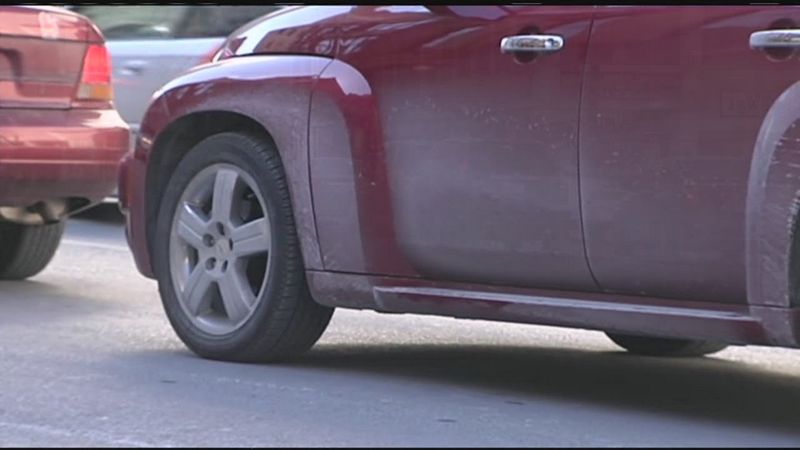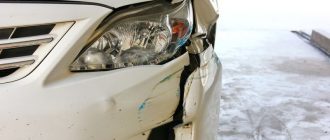
The Impact of Road Salt on Your Car’s Body
Driving on salt-covered roads during winter months can have a detrimental impact on your car’s body. The excessive use of road salt is a common practice to keep roads clear of ice and snow. While it may improve driving conditions, the salt used has long-term effects on your vehicle.
The primary victims of salt damage on cars are the paint and metal surfaces. The corrosive nature of salt can cause paint to chip and peel, leaving the car’s body more susceptible to rust. Salt can also corrode the metal components of the car, weakening its structure and reducing its overall lifespan.
Repeated exposure to salt can speed up the corrosion process, especially in areas where the paint has been chipped or scratched. This is why it is essential to frequently wash your car during winter months to remove any salt residue. Additionally, applying a protective wax coating can help shield the paint from salt damage.
In conclusion, road salt can have a significant impact on your car’s body, causing paint damage and accelerating corrosion on metal surfaces. Taking preventative measures such as frequent car washes and applying protective coatings can help mitigate the effects of salt on your car. It is essential to stay vigilant and treat any chipped or scratched paint promptly to prevent further damage.
The Negative Effects of Road Salt on Your Car’s Body: Paint and Metal Damage
Road salt is commonly used during winter to melt ice and snow on the roads, making them safer for drivers. While road salt is effective in increasing traction, it can have a detrimental effect on your car’s body, specifically the paint and metal.
One of the main reasons why road salt is damaging to your car’s body is its corrosive nature. Salt can cause the paint to chip and peel off, leaving the metal exposed. This exposure can lead to rust formation, which weakens the metal structure of your car.
Furthermore, road salt can also accelerate the oxidation process of the metal. Oxidation occurs when a metal reacts with oxygen in the presence of moisture. The salt residue on your car’s body can trap moisture in the crevices, creating the perfect environment for oxidation to occur. This process can further weaken the metal components of your car.
To mitigate the negative effects of road salt on your car’s body, it is important to regularly wash your car, especially during and after winter. This will help remove the salt residue and prevent any damage to the paint and metal. Additionally, applying a protective wax coating can provide an extra layer of defense against salt and other environmental contaminants.
In conclusion, road salt can have detrimental effects on your car’s body, specifically the paint and metal. The corrosive nature of salt can cause paint damage, leading to rust formation and weakening the metal structure. It is crucial to take preventive measures, such as regular washing and applying protective coatings, to minimize the impact of road salt on your car.
Corrosive Nature of Road Salt
Road salt is commonly used during winter months to melt snow and ice on the road. While it helps improve driving conditions, it can have a negative impact on the car’s body due to its corrosive nature.
When salt comes into contact with the car’s body, it can cause damage to the paint and metal. The salt can easily stick to the car’s surface, especially in hard-to-reach areas such as the undercarriage. As the car drives on the road, the salt can be kicked up onto the body, leading to prolonged exposure.
The corrosive properties of road salt can break down the protective layer of paint on the car’s surface. This can result in the paint becoming dull, faded, or even completely stripped away. Additionally, the salt can cause the metal to rust and corrode, further compromising the car’s body.
To protect the car from the corrosive effects of road salt, it is important to regularly wash the car during the winter months. This will help remove the salt from the car’s surface and prevent it from causing damage. It is also recommended to apply a protective wax or sealant to the car’s paint, which can provide an extra layer of defense against salt corrosion.
Overall, the corrosive nature of road salt can have a detrimental impact on the car’s body. Taking proactive measures to protect the car, such as regular washing and applying protective coatings, can help minimize the damage caused by salt exposure.
How Road Salt Affects Paint
When it comes to the impact of road salt on your car’s body, one of the areas that it affects the most is the paint. The salt used to de-ice the roadways during winter can cause significant damage to the paint on your car.
The road salt contains chloride ions, which are highly corrosive. These ions can easily penetrate the paint’s protective layers and reach the metal surface of the car’s body. Once in contact with the metal, the chloride ions start a chemical reaction that leads to corrosion.
The corrosion process begins with the formation of rust, which weakens the metal’s structural integrity. As rust develops, it can cause the paint to bubble or peel off, exposing the underlying metal to further damage.
The damage caused by road salt is not limited to the visible areas of the car’s body. The salt can also find its way into crevices, seams, and other hard-to-reach areas, where it continues to corrode the metal. Over time, this corrosion can lead to the formation of holes and rust spots, compromising the overall appearance and safety of the car.
In order to minimize the damage caused by road salt, it is important to regularly wash your car during the winter months. This will help remove the salt deposits from the paint surface and prevent corrosion from occurring. It is also recommended to apply a protective wax or sealant to provide an additional layer of defense against the corrosive effects of road salt.
However, it’s important to note that even with these preventive measures, road salt can still cause damage to your car’s paint. Regular inspections and prompt repairs are essential to avoid further deterioration and ensure the longevity of your car’s paint job.
Impact of Road Salt on Metal Components
Road salt can have a severe impact on the metal components of your car. When salt mixes with water on the road, it forms a corrosive solution that can eat away at the metal surfaces it comes into contact with. This can lead to a variety of issues, including rust, paint damage, and weakened metal structures.
The impact of road salt on metal is particularly noticeable on the undercarriage of vehicles. The saltwater solution can seep into crevices and hard-to-reach areas, accelerating the corrosion process. Over time, this can weaken the metal components, making them more susceptible to damage and potential failure.
It is not just the body of the car that is at risk; road salt can also affect other metal parts such as the exhaust system, suspension components, and brake lines. As these components deteriorate, their functionality and performance can be compromised. This can lead to potential safety hazards, as well as expensive repair bills.
Regular cleaning and maintenance are essential to minimize the impact of road salt on your car’s metal components. Washing your car frequently, especially during and after the winter months, can help remove the salt deposits before they have a chance to cause significant damage. Applying a protective coating or wax can also provide an extra layer of defense against salt and other corrosive elements.
In conclusion, road salt poses a significant threat to the metal components of your car. By understanding the potential impact and taking proactive measures to protect and maintain your vehicle, you can help minimize the damaging effects of road salt on your car’s metal surfaces. Remember, prevention is key to prolonging the life of your car and maintaining its overall performance and value.
Rust Formation and Accelerated Corrosion
Road salt has a significant impact on your car’s body, specifically causing rust formation and accelerated corrosion. As salt is used to melt ice and snow on roads, it inevitably comes into contact with vehicles, especially the undercarriage and lower portions of the body.
Salt contains corrosive properties that react with the metal and paint surfaces of your car. When saltwater mixes with oxygen and iron, it creates a chemical reaction that leads to rust formation. Over time, this rust can spread and cause severe damage to the car’s body.
Furthermore, road salt accelerates the corrosion process by acting as a catalyst. It speeds up the rate at which metal surfaces corrode and deteriorate. The combination of salt, moisture, and air creates an ideal environment for corrosion to occur, especially in areas where the protective paint coating has been compromised or worn away.
It is essential to be aware of the potential long-term effects of road salt on your car’s body. Regularly washing your car, especially during the winter months, can help remove salt residue and minimize the risk of rust formation and accelerated corrosion. Additionally, applying a protective coating or wax to the paint can provide an extra layer of defense against the damaging effects of salt.
Salt Residue and Long-Term Damage
The impact of road salt on a car’s body can be seen through the salt residue that is left behind. When the salt mixes with water and splashes onto the car’s surface, it can quickly corrode the paint and metal. The salt residue acts as a catalyst for rust, speeding up the corrosion process.
Over time, if the salt residue is not cleaned off, it can lead to long-term damage to the car’s body. The salt can penetrate the paint and metal, causing them to weaken and deteriorate. This can result in paint peeling, chipping, and bubbling, as well as rust forming on the metal surfaces.
In addition, salt residue can also affect other parts of the car, such as the undercarriage and suspension components. The salt can corrode these areas, leading to structural damage and potential safety hazards.
To prevent long-term damage from salt residue, it is important to regularly wash your car, especially during the winter months when road salt is commonly used. Pay attention to areas where the salt residue is more likely to accumulate, such as the wheel wells, undercarriage, and lower parts of the car.
Salt Accumulation in Hard-to-Reach Areas
When it comes to the impact of road salt on your car’s body, one of the major concerns is the accumulation of salt in hard-to-reach areas. Salt is known for its corrosive properties, and when it comes in contact with the metal and paint of your car, it can cause significant damage.
One of the challenges with salt accumulation is that it tends to gather in areas that are difficult to access during the regular cleaning process. For example, salt can get stuck in the crevices and gaps between panels or in the undercarriage of your car. This can create a hidden reservoir of salt that continues to erode the metal and paint, even after you have cleaned the visible parts of your vehicle.
Furthermore, salt can also accumulate in areas where it may not be immediately visible, such as behind moldings or in the wheel wells. Without proper maintenance, these hidden areas can become a breeding ground for rust and corrosion, leading to long-term damage to your car’s body.
It is important to address salt accumulation in hard-to-reach areas by implementing a regular cleaning routine that includes thorough washing and drying. This will help to remove any salt residue that may have built up, preventing further damage to your car’s body. Additionally, applying a protective wax or sealant can provide an extra layer of defense against salt and other environmental contaminants.
Remember, the impact of road salt on your car’s body is not just limited to the visible parts. Taking preventive measures to address salt accumulation in hard-to-reach areas will help to preserve the integrity of your car’s paint and metal, ensuring its longevity and value.
Importance of Regular Car Washes
Regular car washes are essential for maintaining the overall appearance and condition of your car’s body. The impact of road salt and other environmental factors can be damaging to your car’s finish, causing the paint to chip and the metal to rust over time. Washing your car regularly helps remove these harmful substances and prevents them from causing further damage.
Not only does road salt have a negative impact on the appearance of your car, but it can also affect its resale value. A car with a damaged or rusty body will be less appealing to potential buyers, and it may not fetch as high a price as a well-maintained car. By regularly washing your car, you can protect its value and ensure that it remains in good condition.

In addition to removing road salt, regular car washes also help eliminate other contaminants such as dirt, dust, bird droppings, and tree sap. These substances can stain and corrode your car’s finish if left unchecked. By washing your car regularly, you can prevent these contaminants from causing long-term damage and keep your car looking its best.
Furthermore, regular car washes can help prolong the lifespan of your car’s body. The accumulation of road salt and other corrosive substances can accelerate the rusting process, leading to holes and structural weaknesses in the metal. By removing these substances through regular washing, you can prevent this corrosion and extend the life of your car’s body.
Overall, regular car washes are an essential part of car maintenance. They play a crucial role in protecting your car’s body from the damaging effects of road salt and other contaminants. By investing a little time and effort into regular car washes, you can keep your car looking great and maintain its value for years to come.
Protective Measures for Your Car
When it comes to protecting your car’s body from the damaging effects of road salt, there are several measures you can take. Here are some tips to help you keep your car looking great:
1. Regular Washing: One of the most effective ways to remove salt from your car’s body is by washing it regularly. Make sure to pay extra attention to the underbody and wheel wells, as these areas are most susceptible to salt buildup.
2. Waxing: Applying a coat of wax to your car’s paint can provide an added layer of protection against road salt. The wax creates a barrier that helps prevent the salt from directly contacting the paint surface.
3. Rustproofing: Consider having your car rustproofed to provide an extra level of protection. Rustproofing treatments help seal vulnerable areas and prevent rust from forming on the metal surfaces of your car.
4. Mud Flaps: Installing mud flaps behind your car’s tires can help minimize the amount of road salt and debris that gets kicked up onto the body. The flaps act as a shield, preventing salt from directly contacting the paint and metal.
5. Garage Parking: Whenever possible, park your car in a garage to protect it from exposure to road salt. Keeping your car in a covered area can significantly reduce its contact with salt and prolong its lifespan.
By following these protective measures, you can minimize the impact of road salt on your car’s body and keep it looking its best for years to come.
Waxing and Sealants to Shield Your Car’s Body
When it comes to protecting your car’s body from the damaging road salt, waxing and sealants play a crucial role. These protective measures act as a shield against the corrosive impact of salt on your car’s paint and metal.
Applying a layer of wax creates a barrier on the car’s surface, preventing direct contact between the road salt and the paint. The wax fills in the microscopic pores and imperfections in the paint, giving it a smooth and shiny finish. This not only enhances the appearance of your car but also provides added protection against salt-induced damage.
Sealants, on the other hand, go a step further in shielding your car’s body. These protective coatings are specifically designed to resist the corrosive effects of road salt, ensuring long-lasting protection. Sealants create a durable barrier that seals the surface and safeguards it from the harmful impact of salt. They are usually applied after waxing to provide an extra layer of protection.
It is important to note that waxing and sealants are not a one-time solution. Regular reapplication is necessary, especially during the winter months when road salt usage is high. Applying a fresh coat of wax or sealant every few months helps maintain the protective barrier and ensures continuous protection against salt damage.
Additionally, it is advisable to choose high-quality wax and sealants for maximum effectiveness. Look for products that are designed specifically for cars and provide long-lasting protection. Always follow the manufacturer’s instructions for application and reapplication to ensure the best results.
In conclusion, waxing and sealants are essential for shielding your car’s body from the corrosive impact of road salt. These protective measures create a barrier that prevents salt from directly contacting the paint and metal, thus reducing the risk of damage. Regular application and high-quality products are key to maintaining the protection and keeping your car’s body looking its best.
Undercarriage Cleaning and Rust Prevention
To protect your car’s body from the damaging impact of road salt, it is important to pay attention to the undercarriage. The undercarriage is particularly susceptible to salt because it is constantly exposed to the corrosive substance on the roads.
To prevent rust and damage to your car’s undercarriage, it is recommended to regularly clean it. This can be done by taking your car to a professional car wash that offers undercarriage cleaning services. These services typically use high-pressure water and specialized cleaning products to remove salt and other contaminants from the undercarriage.
It is also important to inspect the undercarriage of your car regularly for any signs of rust or corrosion. If you notice any rusty spots or flaking paint, it is crucial to address it as soon as possible. You can use a wire brush or sandpaper to remove the rust, and then apply a rust prevention primer and paint to protect the metal.
Additionally, applying a rust inhibitor or undercoating to the undercarriage can provide extra protection. These products create a barrier between the salt and the metal, preventing corrosion from occurring. They should be applied following the manufacturer’s instructions and reapplied as needed.
Remember that prevention is key when it comes to protecting your car’s undercarriage from salt. Regular cleaning, inspection, and maintenance can go a long way in preserving the integrity of your car’s body, preventing rust, and extending the lifespan of your vehicle.
Takeaways:
- Regularly clean the undercarriage of your car to remove salt and other contaminants.
- Inspect the undercarriage for signs of rust or corrosion and address them promptly.
- Apply a rust inhibitor or undercoating to protect the metal from salt and corrosion.
- Prevention is key in protecting your car’s undercarriage and extending the lifespan of your vehicle.
Avoiding Salted Roads and Alternative Routes
During the winter months, road salt is commonly used to prevent icy conditions on the road. However, this salt can have a detrimental impact on your car’s body, specifically the paint and metal. To avoid unnecessary damage, it is important to be aware of salted roads and consider alternative routes.
First and foremost, it’s crucial to stay informed about which roads are being salted. Local news sources often provide updates on road conditions, including areas where road salt is being applied. By staying aware of these updates, you can plan your routes accordingly.
If possible, it is recommended to avoid salted roads altogether. This can be achieved by taking alternative routes that are less likely to have been treated with road salt. For example, you can use navigation apps or websites to find alternate paths that minimize your exposure to salted roads.
When planning your route, consider using major highways and well-traveled roads. These routes are often prioritized for snow removal and are less likely to be heavily salted. Additionally, these roads are usually cleared more frequently, reducing the amount of salt buildup.
If avoiding salted roads is not feasible, there are some measures you can take to protect your car’s body. Regularly washing your car can help remove salt residue from the paint and metal. Pay extra attention to the undercarriage and wheel wells, as these areas are particularly vulnerable to salt damage.
In conclusion, being aware of salted roads and taking alternative routes can help minimize the impact of road salt on your car’s body. By planning your routes carefully and regularly washing your car, you can protect the paint and metal from the damaging effects of salt.
The Role of Car Mats and Mud Flaps
Car mats and mud flaps play a crucial role in protecting your car’s body from the damaging impact of road salt. When you drive on roads treated with salt to melt snow and ice, the salt can stick to your car’s tires and undercarriage. As you drive, the salt can be sprayed onto your car’s body, leading to corrosion and damage to the paint and metal.
Car mats act as a barrier between the salt and your car’s carpeting or flooring. They help to trap and contain the salt, preventing it from seeping into the carpet and causing damage. By regularly cleaning and maintaining your car mats, you can remove the salt and prevent it from causing long-term damage to your car’s interior.
Mud flaps, on the other hand, are installed behind the tires and help to minimize the spray of salt, mud, and other debris onto the car’s body. They catch the spray and redirect it back down to the ground, preventing it from reaching the vulnerable areas of your car’s paint and metal.
By using car mats and mud flaps, you can significantly reduce the impact of road salt on your car’s body. They provide an extra layer of protection and help to preserve the appearance and structural integrity of your vehicle.
Question-answer:
What is road salt?
Road salt is a substance composed of sodium chloride, calcium chloride, or magnesium chloride, which is spread on roads during winter to melt ice and snow.
How does road salt damage a car’s paint?
Road salt can damage a car’s paint by causing corrosion and rust. It creates a chemical reaction with the metal, which can break down the paint’s protective barrier and lead to chipping and peeling.
What are the signs that road salt has damaged a car’s paint?
The signs of road salt damage on a car’s paint can include rust spots, paint discoloration, chipping or peeling of paint, and the appearance of small bubbles or blisters on the surface.
How can road salt affect a car’s metal body?
Road salt can accelerate the process of corrosion on a car’s metal body. It can penetrate the metal surface and cause rusting, weakening the structure and leading to a higher risk of structural damage.
What can be done to protect a car’s body from road salt damage?
To protect a car’s body from road salt damage, it is recommended to regularly wash the car, especially the undercarriage, during the winter months. Applying a protective wax or sealant can also help create a barrier between the salt and the paint. Additionally, keeping the car in a garage or covered area can minimize exposure to salt.





